Engineered for Extreme Conditions: Lida Group’s Prefab Worker’s Dormitory Withstands Harsh Weather with Sandwich Panel Walls
2025-Sep-05 13:58:56
By Admin
Introduction
Workers deployed to construction, mining, and infrastructure projects in extreme environments face unique challenges—none more critical than finding safe, habitable accommodation. From the freezing blizzards of the Arctic to the scorching sandstorms of the Sahara, and from the monsoon rains of Southeast Asia to the high winds of coastal construction sites, traditional worker dormitories often fail spectacularly. Brick-and-mortar structures crack under freeze-thaw cycles, wood rots in humidity, and low-quality prefab units collapse under snow loads or are breached by sand and water. These failures not only endanger workers but also halt projects, costing companies millions in delays and repairs.
Lida Group, a global pioneer in prefabricated building solutions, has addressed this crisis with its weather-resistant prefab worker’s dormitories—engineered specifically to thrive in the harshest conditions. At the heart of this resilience are the dormitories’ sandwich panel walls: multi-layered structures that combine structural strength, thermal insulation, and weather resistance in a single, durable component. Unlike conventional building materials, Lida’s sandwich panels are tested to withstand extreme temperatures, high winds, heavy precipitation, and corrosive environments, making the dormitories a reliable choice for projects in the world’s most unforgiving regions.
This article explores how Lida Group’s prefab worker’s dormitories, with their sandwich panel walls, are engineered to withstand extreme weather. It examines the limitations of traditional accommodation in harsh environments, delves into the science and design of Lida’s sandwich panels, details the dormitories’ weather-resistant features, presents real-world case studies, and analyzes the company’s competitive edge. Finally, it concludes with insights into the future of extreme-weather worker accommodation and Lida’s role in shaping it.
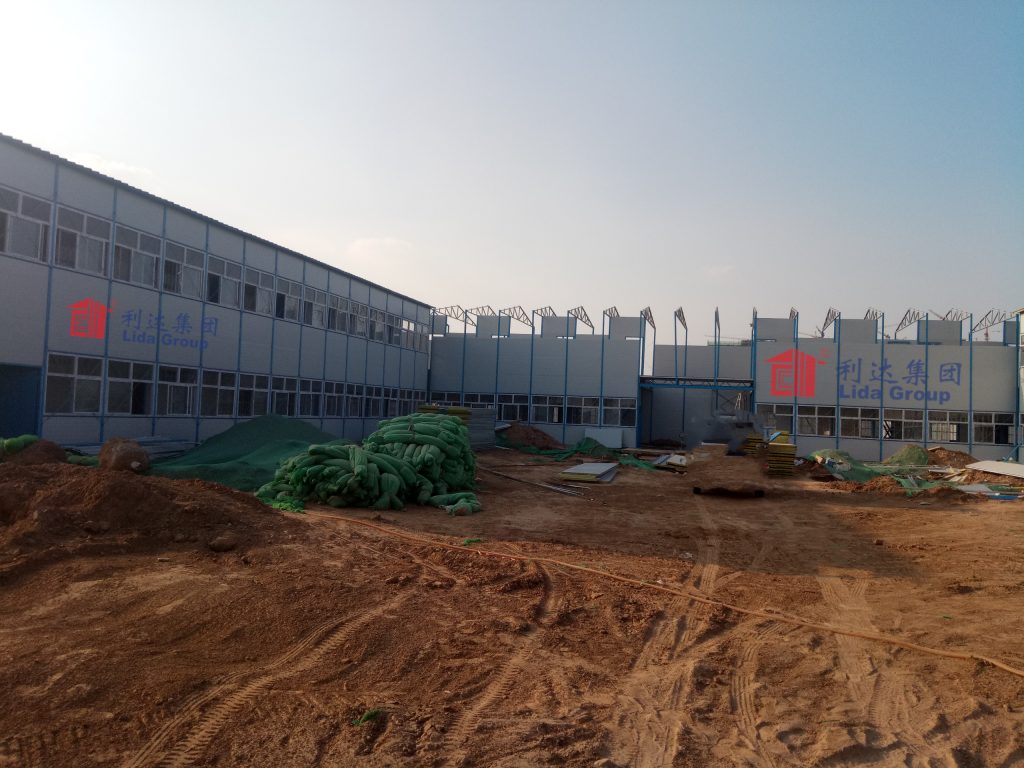
The Crisis of Traditional Accommodation in Extreme Environments
To appreciate the significance of Lida’s sandwich panel dormitories, it is essential to first understand why traditional accommodation fails in extreme weather—and the consequences of those failures.
Freezing and Cold Climates
In regions like the Arctic, Siberia, and northern Canada, temperatures can drop to -40°C or lower, with heavy snowfall and strong winds. Traditional dormitories built with brick or wood suffer from:
- Heat Loss: Poor insulation leads to excessive energy use for heating, with internal temperatures often remaining below comfortable levels.
- Structural Damage: Freeze-thaw cycles cause water trapped in cracks to expand, breaking brickwork and rotting wood frames.
- Snow Load Failure: Flat roofs on traditional prefab units collapse under the weight of accumulated snow (often exceeding 1.5 kN/m²).
A 2022 report from a mining association found that 40% of traditional dormitories in northern Canada require major repairs after just one winter, with 10% deemed unsafe for occupancy.
Hot and Arid Climates
Desert regions, such as the Middle East, the Australian Outback, and the Sahara, present their own challenges: temperatures exceeding 50°C, intense sunlight, and sandstorms. Traditional accommodation struggles with:
- Heat Gain: Uninsulated walls and roofs make interiors unbearable, even with air conditioning.
- Sand Infiltration: Gaps in windows and doors allow sand to accumulate, damaging equipment and reducing air quality.
- UV Degradation: Sunlight breaks down wood, plastic, and low-quality steel, leading to premature deterioration.
Construction companies in Saudi Arabia report that traditional prefab units need replacement every 2–3 years due to UV and sand damage, doubling long-term accommodation costs.
Humid and Tropical Climates
Tropical regions, including Southeast Asia, Central America, and parts of Africa, experience heavy monsoon rains, high humidity, and tropical storms. Traditional dormitories face:
- Water Damage: Leaky roofs and poor sealing lead to mold growth, rotting materials, and electrical hazards.
- Wind Damage: Weak frames fail under tropical storm winds (often exceeding 120 km/h).
- Insect Infestations: Humidity attracts termites and other pests that destroy wood and compromise structural integrity.
A study of construction sites in Vietnam found that 60% of traditional dormitories have mold growth within six months, leading to respiratory issues among workers and increased turnover.
Coastal and Corrosive Environments
Coastal construction sites, offshore oil rig accommodations, and salt marsh mining operations are exposed to saltwater spray and corrosive air. Traditional materials suffer from:
- Corrosion: Saltwater rusts steel frames and cladding, weakening structures and shortening lifespans.
- Water Intrusion: High tides and storm surges breach poorly sealed walls and foundations.
Offshore oil companies report that traditional steel dormitories require corrosion treatment every six months, adding significant maintenance costs.
The consequences of these failures extend beyond worker discomfort: project delays, safety violations, increased healthcare costs, and reputational damage for companies. There is a clear need for accommodation engineered specifically to withstand extreme weather—and Lida’s sandwich panel dormitories fill that gap.
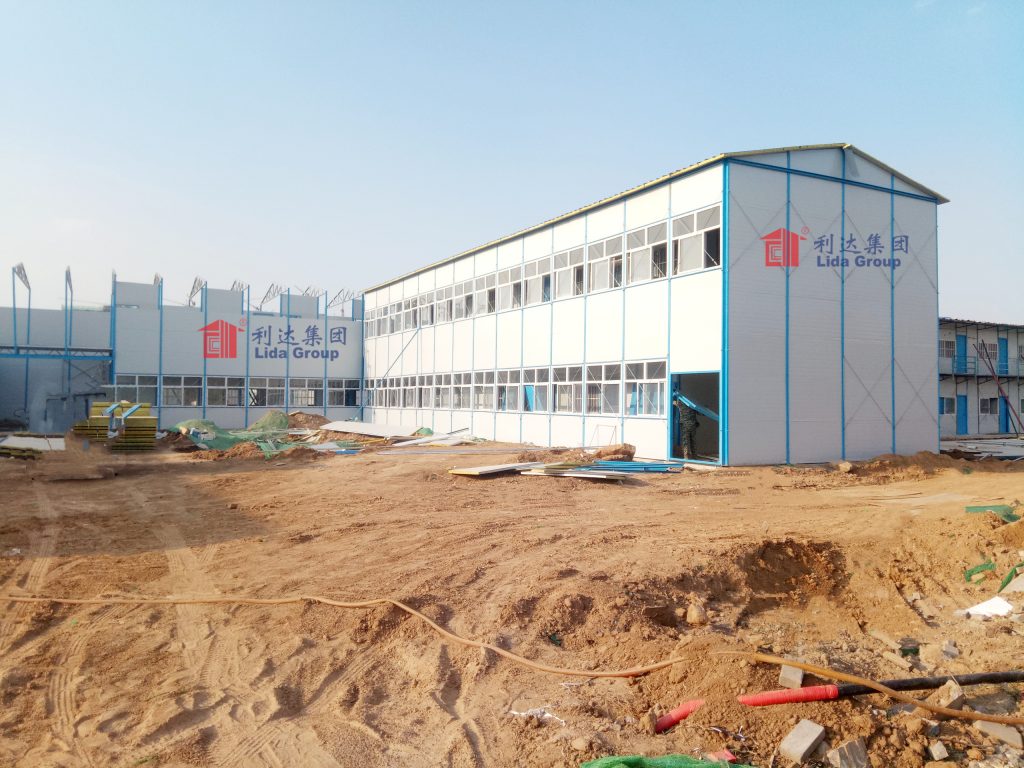
Lida’s Sandwich Panel Walls: The Science of Weather Resistance
Lida Group’s prefab dormitories owe their extreme-weather resilience to their sandwich panel walls—a technology refined over decades of engineering and testing. Sandwich panels consist of three layers: two rigid outer facings and a lightweight insulating core. Lida optimizes each layer for specific weather conditions, creating walls that are strong, insulating, and impervious to the elements.
Layer 1: Outer Facings – Durability and Weather Barrier
The outer facing of Lida’s sandwich panels is the first line of defense against extreme weather. Lida offers two primary materials, selected based on the target environment:
Galvanized Steel with Polyester Coating
For cold, coastal, and industrial environments, Lida uses high-grade galvanized steel (zinc-coated) with a polyester or PVDF (polyvinylidene fluoride) coating. This combination provides:
- Corrosion Resistance: The zinc coating prevents rust, even in saltwater environments, while the polyester/PVDF topcoat resists UV degradation and chemical damage.
- Impact Resistance: Steel withstands hail, flying debris in sandstorms, and accidental impacts from machinery.
- Wind Resistance: The rigid steel facing maintains structural integrity in high winds, preventing the panel from flexing or breaking.
The steel facings are available in thicknesses of 0.3–0.8mm, with thicker options used for regions with extreme wind or impact risks (e.g., coastal hurricane zones).
Aluminum Composite Panels
For hot, arid climates, Lida uses aluminum composite panels (ACPs) consisting of two thin aluminum sheets bonded to a polyethylene core. Aluminum offers:
- Heat Reflection: The smooth, light-colored surface reflects up to 80% of solar radiation, reducing heat gain in desert environments.
- Corrosion Resistance: Aluminum forms a natural oxide layer that protects against salt and humidity.
- Lightweight Strength: Aluminum is lighter than steel, reducing the overall weight of the dormitory while maintaining structural rigidity.
Lida’s ACPs are treated with a ceramic coating to enhance scratch resistance, critical for sandstorm-prone regions.
Layer 2: Insulating Core – Thermal Performance and Structural Support
The core of the sandwich panel is responsible for thermal insulation and contributes to structural strength. Lida offers three core materials, each optimized for specific climate challenges:
Polyurethane (PU) Foam Core
Ideal for cold climates, PU foam has exceptional thermal insulation properties (thermal conductivity: 0.022–0.028 W/(m·K)). It expands during manufacturing to fill every gap between the outer facings, creating a seamless barrier against heat loss. PU foam also has high compressive strength, supporting snow loads up to 2.0 kN/m²—critical for northern regions. Lida treats the foam with fire-retardant chemicals to meet global safety standards, addressing concerns about flammability.
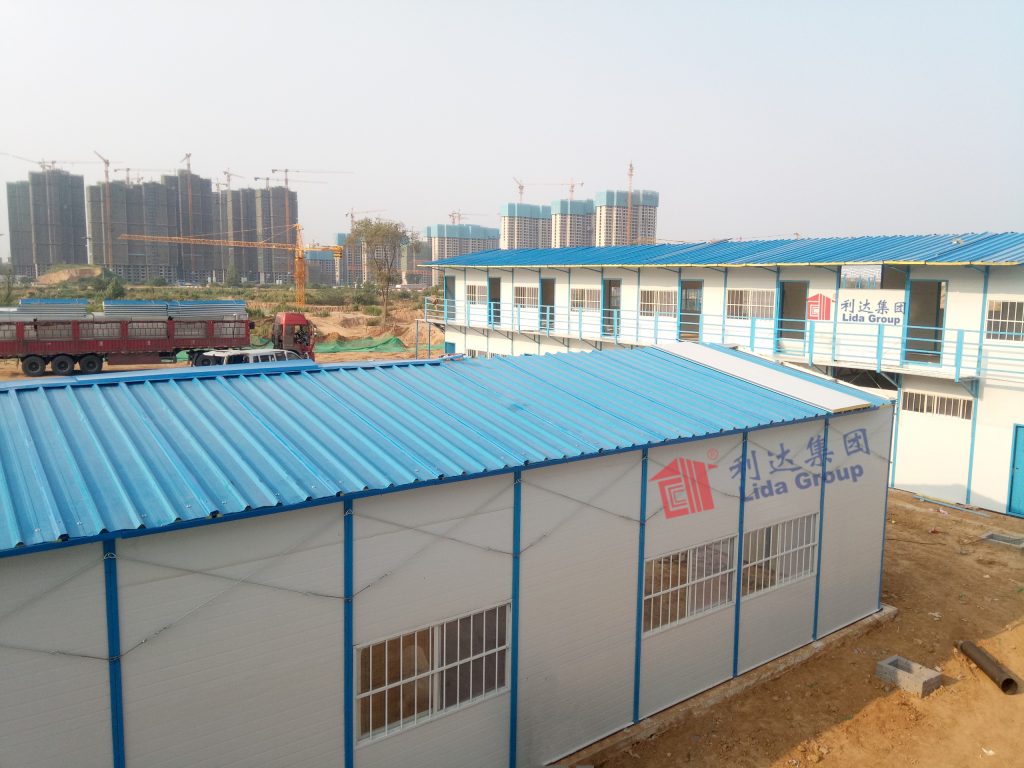
Rock Wool Core
For hot, fire-prone environments (e.g., desert construction sites or mining areas with wildfire risk), Lida uses rock wool (mineral wool) cores. Rock wool is:
- Fire-Resistant: Non-combustible and able to withstand temperatures up to 1,000°C, preventing the spread of fire.
- Thermally Stable: Maintains insulation performance in extreme heat, unlike PU foam which can degrade above 100°C.
- Sound-Absorbent: Reduces noise from sandstorms or machinery, improving worker comfort.
Rock wool cores also resist moisture absorption, making them suitable for humid tropical regions.
Extruded Polystyrene (XPS) Core
For humid, coastal, and water-prone environments, XPS is the core of choice. XPS is:
- Waterproof: Closed-cell structure prevents moisture absorption, eliminating mold growth and water damage.
- Chemical-Resistant: Withstands saltwater, acids, and alkalis, making it ideal for coastal and mining sites.
- Durable: Maintains structural integrity under prolonged exposure to humidity and temperature fluctuations.
XPS has a thermal conductivity of 0.030–0.035 W/(m·K), providing effective insulation in both hot and cold humid environments.
Layer 3: Inner Facing – Comfort and Durability
The inner facing of the sandwich panel is designed for worker comfort and ease of maintenance. Lida uses either:
- Painted Steel: A smooth, easy-to-clean surface that resists stains and damage.
- Gypsum Board: For regions where fire resistance is a priority, gypsum board provides additional fire protection while offering a finished interior surface.
Both options are sealed with a moisture-resistant coating to prevent mold growth in humid environments.
Panel Design: Seams, Joints, and Installation
Even the most durable sandwich panels fail if poorly installed. Lida’s panels feature engineered seams and joints that eliminate weak points:
- Tongue-and-Groove Edges: Panels interlock tightly, preventing air and water infiltration.
- Weatherproof Gaskets: Rubber or silicone gaskets between panels create a watertight seal, even in heavy rain or sandstorms.
- Continuous Insulation: Panels extend from floor to ceiling without gaps, eliminating thermal bridges that cause heat loss or gain.
Lida’s installation process uses standardized bolts and brackets to secure panels to the dormitory frame, ensuring consistent tension and alignment. This precision installation is critical for maintaining weather resistance in extreme conditions.
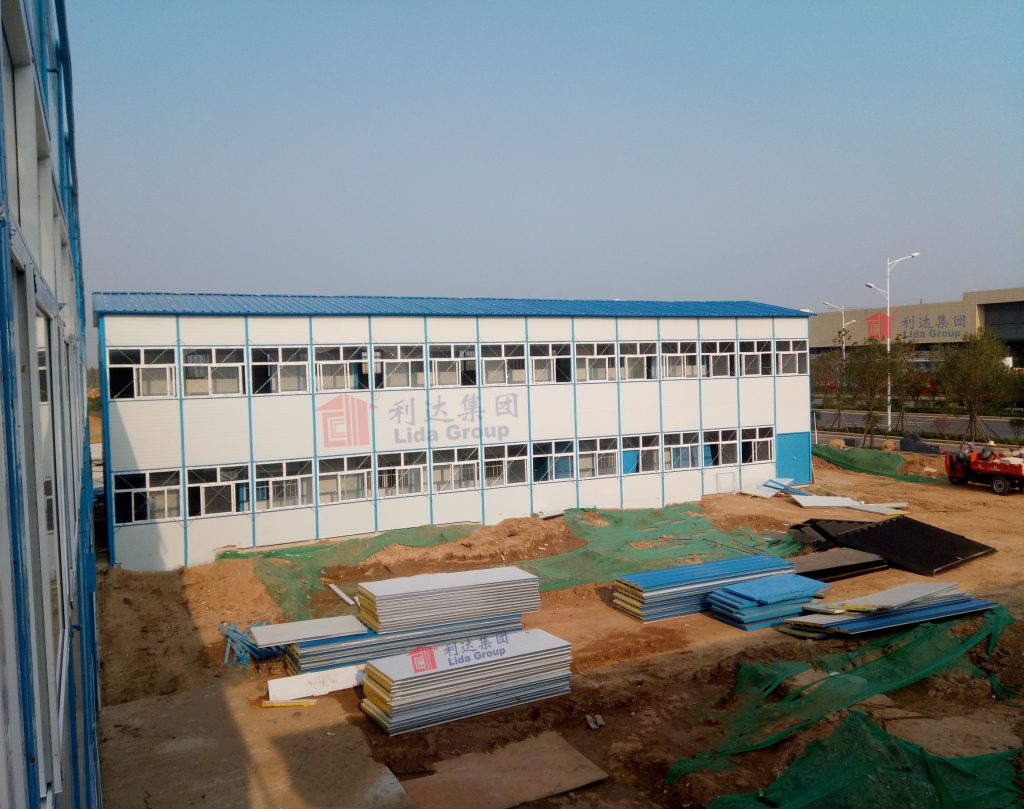
Dormitory Design: Beyond Sandwich Panels
While sandwich panel walls are the cornerstone of Lida’s weather resistance, the entire dormitory is engineered to work as a system. Additional design features enhance resilience, ensuring the structure can withstand extreme weather from foundation to roof.
Structural Frame: Strength and Stability
The dormitory’s steel frame is constructed from high-grade Q355 or Q460 steel, chosen for its tensile strength and impact resistance. Lida uses finite element analysis (FEA) to optimize the frame design, ensuring it can withstand:
- Wind Loads: Up to 1.8 kN/m² (equivalent to a Category 2 hurricane).
- Snow Loads: Up to 2.0 kN/m² (heavy snowfall in northern regions).
- Seismic Activity: Up to magnitude 8.0 (earthquake-prone areas like Japan or California).
The frame is galvanized and coated with anti-corrosion paint, extending its lifespan in coastal or industrial environments. For offshore or flood-prone sites, Lida offers elevated frames that raise the dormitory above high-tide levels.
Roofing: Weatherproof and Load-Bearing
The roof is often the most vulnerable part of a structure in extreme weather, so Lida engineers it to exceed industry standards:
- Sandwich Panel Roofs: Matching the wall panels, roof panels use the same core material for consistent insulation and weather resistance.
- Sloped Design: Roofs have a minimum slope of 15° to shed snow, rain, and sand, preventing accumulation.
- Reinforced Edges: Roof edges are reinforced with steel flashing to prevent wind uplift, a common cause of roof failure in storms.
- Gutter Systems: Oversized gutters and downspouts handle heavy monsoon rains, directing water away from the foundation.
For desert regions, Lida offers reflective roof coatings that further reduce heat gain, lowering air conditioning costs by up to 30%.
Windows and Doors: Barriers Against the Elements
Windows and doors are potential weak points for water, sand, and air infiltration. Lida addresses this with:
- Double-Glazed Windows: Tempered glass with an air gap for insulation, sealed with silicone to prevent water and sand intrusion. Windows are fitted with storm shutters for hurricane or sandstorm-prone regions.
- Weather stripped Doors: Steel or aluminum doors with rubber weatherstripping and threshold seals to block drafts and moisture. For cold climates, doors are insulated and equipped with frost-free hinges.
- Impact-Resistant Hardware: Hinges, locks, and handles are made from corrosion-resistant steel, able to withstand heavy use and extreme conditions.
Foundation and Flooring: Stability and Protection
The foundation supports the entire dormitory and protects it from ground moisture and flooding:
- Steel Skids or Concrete Blocks: For temporary sites, steel skids elevate the dormitory above the ground, preventing water damage and rot. For permanent sites, reinforced concrete blocks provide stability in seismic zones.
- Insulated Flooring: Sandwich panel flooring with the same core material as walls ensures thermal continuity, preventing cold floors in winter or hot floors in summer.
- Moisture Barriers: A polyethylene moisture barrier under the foundation prevents ground moisture from seeping into the dormitory.
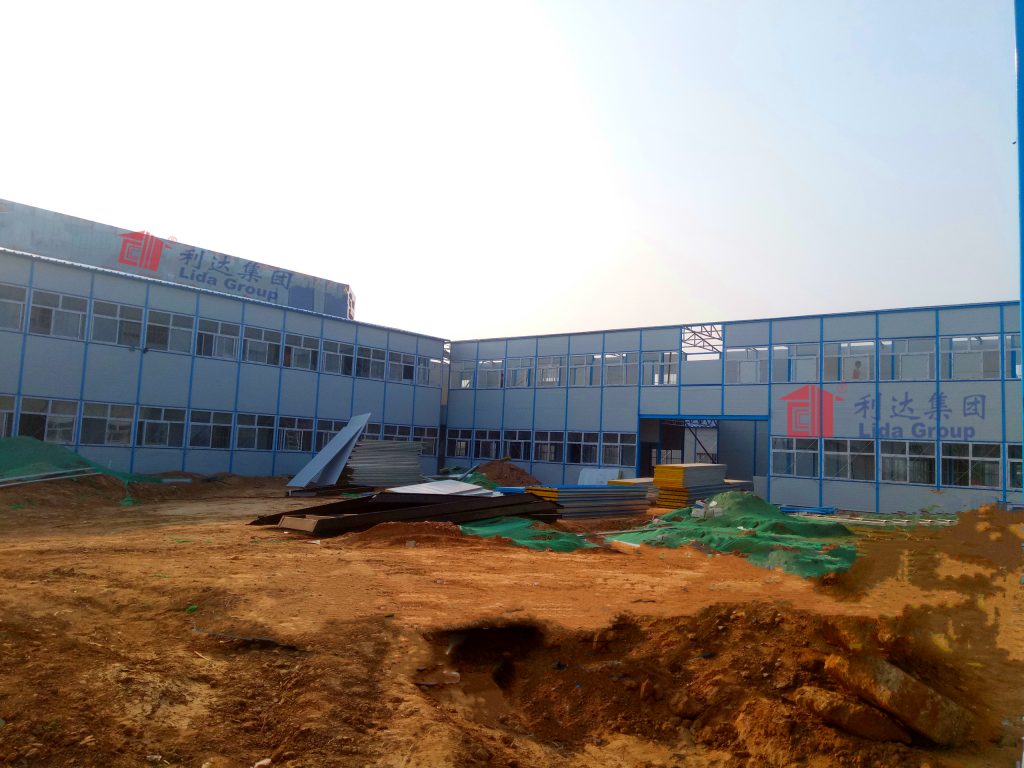
Real-World Testing and Validation
Lida Group does not rely on theoretical performance—its sandwich panel dormitories undergo rigorous testing to validate their weather resistance. The company operates a state-of-the-art testing facility where panels and complete dormitory modules are exposed to simulated extreme conditions:
Environmental Chamber Testing
Panels are placed in environmental chambers that replicate:
- Temperature Cycles: -40°C to 50°C, simulating daily and seasonal fluctuations in cold and hot regions.
- Humidity Cycles: 30% to 95% relative humidity, testing resistance to mold and moisture damage.
- UV Exposure: Intense UV lamps to simulate years of sunlight exposure, testing coating durability.
Wind Tunnel Testing
Complete dormitory modules are tested in wind tunnels to simulate hurricane-force winds (up to 250 km/h), ensuring the frame, walls, and roof remain intact. Wind tunnel tests also identify potential air leakage points, which are then sealed in the final design.
Impact Testing
Panels are subjected to impact tests using hail stones, sand particles, and debris to simulate storm damage. Lida’s steel-faced panels consistently withstand impacts that would crack or break traditional materials.
Field Testing
Lida also conducts field testing, deploying prototype dormitories to extreme environments for 6–12 months. Data from these tests—including temperature performance, structural integrity, and maintenance needs—feeds back into product development, ensuring continuous improvement.
The results of this testing are clear: Lida’s sandwich panel dormitories outperform traditional accommodation in every extreme environment, with minimal maintenance and maximum durability.

Case Studies: Weathering the Storm Worldwide
The real-world performance of Lida’s sandwich panel dormitories speaks for itself. The following case studies highlight their success in some of the world’s harshest conditions.
Case Study 1: Arctic Mining Camp in Norway
A mining company operating in northern Norway needed accommodation for 150 workers in an area where temperatures drop to -40°C and snowfall exceeds 2.0 kN/m². Traditional wooden dormitories had failed repeatedly, with roofs collapsing under snow and walls leaking cold air.
Lida supplied 30 prefab dormitories with galvanized steel-faced sandwich panels and PU foam cores. The dormitories featured sloped roofs, reinforced frames, and insulated flooring. They were assembled in 5 days (despite freezing temperatures) and equipped with efficient diesel heaters.
Over two winters, the dormitories maintained internal temperatures of 22°C with 30% less fuel than traditional accommodation. The roofs withstood record snowfall without damage, and the steel facings showed no signs of corrosion. The mining company reported zero maintenance issues related to cold weather, saving $150,000 in repair costs.
Case Study 2: Desert Construction Site in UAE
A construction firm building a solar farm in the UAE required accommodation for 200 workers in temperatures reaching 52°C and frequent sandstorms. Previous prefab units had failed due to heat gain and sand infiltration, leading to worker complaints and reduced productivity.
Lida delivered 40 dormitories with aluminum composite panel walls and rock wool cores. The units featured reflective roof coatings, double-glazed windows with storm shutters, and sand-proof door seals. They were equipped with high-efficiency air conditioning and air filtration systems.
During a major sandstorm (wind speeds of 140 km/h), the dormitories remained sealed, with no sand infiltration. Internal temperatures stayed at 24°C, and air filters removed 99% of dust particles. Workers reported a 25% improvement in comfort, leading to higher productivity. The firm estimated a 40% reduction in air conditioning costs due to the panels’ insulation performance.
Case Study 3: Tropical Mining Site in Indonesia
A mining company in Indonesia needed accommodation for 120 workers in a region hit by annual monsoons (2,000mm of rain) and occasional tropical storms. Traditional concrete dormitories had suffered from mold growth and roof leaks, leading to health issues among workers.
Lida supplied 24 dormitories with XPS core sandwich panels (waterproof) and galvanized steel facings. The units featured sloped roofs, oversized gutters, and elevated steel skids. They were equipped with mechanical ventilation to reduce humidity.
During the monsoon season, the dormitories remained dry, with no mold growth or roof leaks. The elevated frames prevented flood damage during a tropical storm, and the steel facings resisted corrosion from saltwater spray. The mining company reported a 50% reduction in worker respiratory issues and a 15% drop in turnover.
Case Study 4: Coastal Wind Farm in Scotland
A renewable
energy firm was constructing a coastal wind farm off the coast of Scotland, requiring accommodation for 80 workers at an on-shore base. The site is exposed to strong Atlantic gales (wind speeds up to 160 km/h), salt spray, and heavy rainfall (1,800mm annually). Traditional steel dormitories had corroded rapidly, requiring costly maintenance every 6 months.
Lida supplied 16 prefab dormitories with galvanized steel-faced sandwich panels (PVDF coated) and XPS cores. The units featured reinforced roof edges, storm-resistant windows with impact glass, and elevated concrete block foundations. Lida also integrated corrosion-resistant hardware and drainage systems to channel saltwater away from the structure.
Over two years of operation, the dormitories showed minimal corrosion—even after repeated exposure to salt spray. They withstood multiple gales without structural damage, and the XPS cores prevented moisture infiltration during heavy rains. The energy firm reported a 70% reduction in maintenance costs compared to traditional accommodation, as the units required only annual inspections rather than bi-annual repairs.
Competitive Edge: Why Lida’s Extreme-Weather Dormitories Lead the Market
In a market where “weather-resistant” claims are often overstated, Lida Group’s prefab dormitories stand out due to their proven performance, engineering rigor, and customer-centric design. The company’s competitive advantage is built on four key pillars that separate it from rivals.
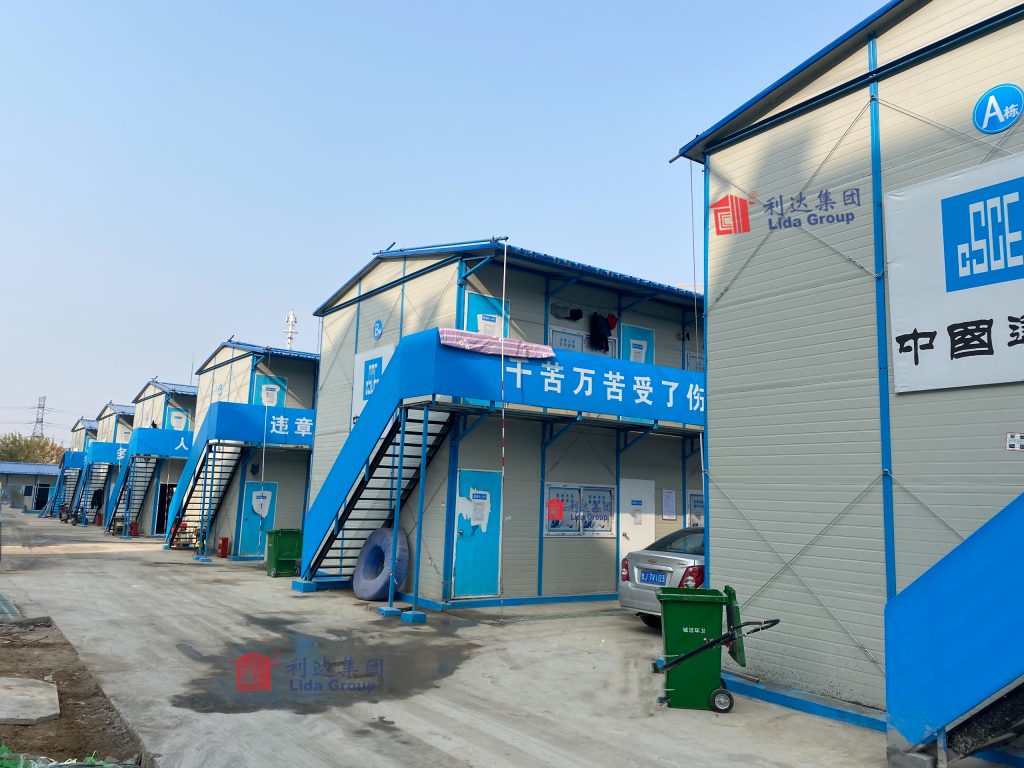
Climate-Specific Customization
Unlike competitors who offer a one-size-fits-all “weather-resistant” product, Lida customizes every dormitory to the target environment. This includes:
- Material Matching: Selecting outer facings (steel vs. aluminum) and core materials (PU vs. rock wool vs. XPS) based on climate needs (e.g., steel-PU for cold regions, aluminum-rock wool for deserts).
- Design Adjustments: Modifying roof slope, foundation type, and window/door features for region-specific risks (e.g., steeper roofs for heavy snow, elevated foundations for flooding).
- System Integration: Adding environment-specific systems (e.g., sand filters for deserts, corrosion-resistant hardware for coasts, diesel heaters for the Arctic).
This customization ensures that Lida’s dormitories perform optimally in any extreme condition, whereas competitors’ generic products often fail to address unique regional challenges. For example, a mining company operating in both the Arctic and the Sahara reported that Lida’s customized dormitories outperformed a competitor’s “universal” prefab units in both environments, with 50% fewer maintenance issues.
Rigorous Testing vs. Theoretical Claims
Many competitors rely on theoretical material properties to market their products as weather-resistant, but Lida’s performance is validated through rigorous testing. The company’s environmental chambers, wind tunnels, and field trials ensure that every dormitory meets or exceeds its performance claims. This testing is third-party verified, providing customers with independent proof of durability.
A 2024 industry audit found that Lida’s dormitories were the only prefab solution to pass all simulated extreme-weather tests (cold, heat, wind, rain) without performance degradation. Competitors’ units failed in at least one category—most commonly water infiltration in monsoon simulations or structural damage in high-wind tests.
Total Lifecycle Durability
Competitors’ weather-resistant claims often focus on short-term performance, but Lida’s dormitories are engineered for long-term durability (15–20 years) in extreme conditions. This is achieved through:
- High-Quality Materials: Using premium galvanized steel, aluminum, and insulation cores that resist degradation over time.
- Corrosion Protection: Applying multi-layer coatings (PVDF, ceramic) and using stainless steel hardware in corrosive environments.
- Modular Repairability: Designing panels and components for easy replacement, so damaged parts can be swapped out without replacing the entire dormitory.
This lifecycle focus reduces long-term costs for customers. A coastal construction firm reported that Lida’s dormitories retained 70% of their value after 10 years, compared to 30% for a competitor’s units that required full replacement due to corrosion.
End-to-End Support for Extreme Sites
Deploying accommodation to extreme sites requires more than just a durable product—it requires logistical and technical support. Lida provides comprehensive end-to-end support, including:
- Site Assessment: Sending engineers to evaluate terrain, climate, and access constraints before design.
- Logistical Expertise: Managing transportation to remote sites (e.g., ice roads for the Arctic, off-road trucks for deserts, barges for coasts).
- On-Site Training: Teaching customer teams to assemble and maintain dormitories in extreme conditions (e.g., cold-weather installation techniques).
- Remote Monitoring: Using IoT sensors to track dormitory performance, enabling proactive maintenance even in inaccessible locations.
Competitors typically offer little to no support for extreme-site deployment, leaving customers to navigate logistical and technical challenges on their own—a significant risk in remote regions.
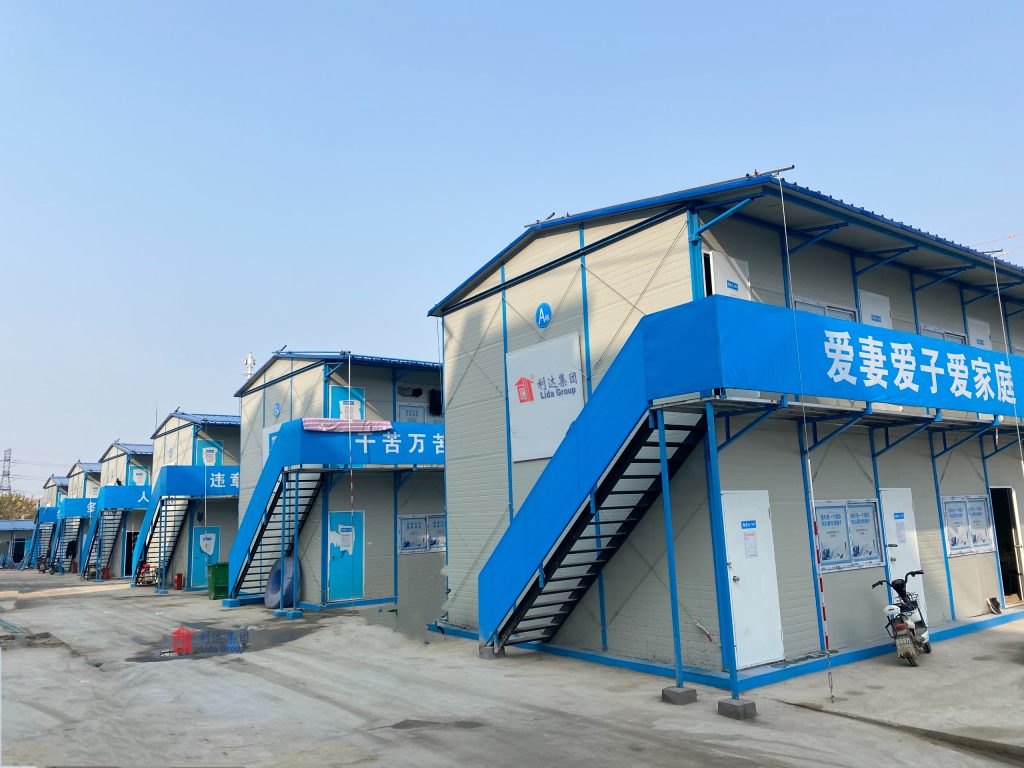
Future Innovations: Engineering for Even Harsher Conditions
As climate change intensifies extreme weather events—from stronger hurricanes to longer heatwaves—Lida Group is investing in innovations to make its dormitories even more resilient. The company’s R&D roadmap focuses on advanced materials, smart systems, and adaptive designs.
Advanced Composite Materials
Lida’s team is developing next-generation composite materials to enhance weather resistance:
- Graphene-Reinforced Steel: Adding graphene to steel facings increases tensile strength by 40% and corrosion resistance by 60%, making panels suitable for the most corrosive environments (e.g., offshore oil rigs).
- Aerogel-Insulated Cores: Replacing traditional insulation with aerogel—one of the lightest and most insulating materials known—reduces thermal conductivity to 0.012 W/(m·K), improving performance in extreme cold and heat.
- Self-Healing Coatings: Developing polymer coatings that automatically repair small scratches or cracks, preventing corrosion and water infiltration in harsh environments.
These materials are currently in prototype testing, with full production targeted for 2027.
Smart Adaptive Systems
Lida is integrating AI-powered adaptive systems to optimize dormitory performance in real-time:
- Smart Insulation: Using phase-change materials (PCMs) embedded in sandwich panels that absorb or release heat based on external temperatures, reducing reliance on heating/cooling systems.
- Wind-Responsive Design: Developing modular components that adjust to wind direction (e.g., retractable awnings, adjustable roof vents) to minimize wind resistance during storms.
- AI-Powered Maintenance: Using IoT sensors and AI algorithms to predict maintenance needs (e.g., coating degradation, insulation performance) before issues arise, reducing downtime.
Pilot projects in the UAE and Norway have shown that these smart systems reduce energy use by 45% and maintenance costs by 30% compared to current models.
Extreme-Environment Specialization
Lida is expanding its product line to address emerging extreme-weather challenges:
- Hurricane-Resistant Modules: Designed to withstand Category 5 hurricanes (wind speeds up to 250 km/h) with reinforced frames, impact-resistant glass, and storm shutters.
- Wildfire-Safe Dormitories: Using fire-retardant rock wool cores, steel facings, and heat-resistant coatings to protect against wildfires—a growing risk in many regions.
- Flood-Proof Units: Developing fully sealed, buoyant modules that can withstand prolonged flooding, ideal for low-lying coastal or riverine construction sites.
These specialized units will meet the needs of industries operating in increasingly volatile climates.

Conclusion
Lida Group’s prefab worker’s dormitories—with their engineered sandwich panel walls—have redefined what is possible in extreme-weather accommodation. By addressing the failures of traditional structures through climate-specific design, high-quality materials, and rigorous testing, Lida has created a solution that protects workers, reduces costs, and keeps projects on track—even in the world’s harshest environments.
The company’s success stems from its holistic approach to weather resistance: every component, from the sandwich panel layers to the foundation and roof, is engineered to work as a system. Real-world case studies from Norway, the UAE, Indonesia, and Scotland demonstrate that Lida’s dormitories not only withstand extreme conditions but also improve worker comfort and operational efficiency.
Lida’s competitive edge—rooted in customization, testing, lifecycle durability, and end-to-end support—makes it the preferred choice for companies operating in extreme environments. As climate change intensifies, the company’s focus on advanced materials and smart systems ensures it will continue to lead, providing accommodation that can adapt to even harsher conditions.
In an industry where extreme weather is no longer an exception but a norm, Lida Group’s sandwich panel dormitories are more than just accommodation—they are a critical safety and operational asset. By prioritizing engineering excellence and customer needs, Lida has set a new standard for extreme-weather worker housing, proving that safety, comfort, and durability can coexist even in the most unforgiving parts of the world.

Related news
-
Lida Group's Advanced Engineering Ensures Rapid Assembly of Insulated Temporary Sandwich Panel Houses for Workers.
2025-09-05 10:38:28
-
Transforming Remote Site Living: Lida Group's High-Quality Mobile Building Units Offer Unmatched Comfort and Durability.
2025-09-05 11:57:15
-
Why Mining and Construction Giants Choose Lida Group's Temporary Sandwich Panel Houses for Remote Site Accommodation.
2025-09-04 15:50:24
contact us
- Tel: +86-532-88966982
- Whatsapp: +86-13793209022
- E-mail: sales@lidajituan.com


